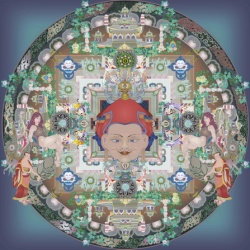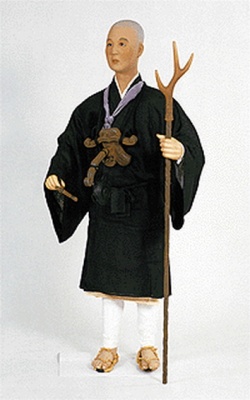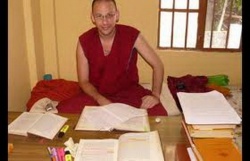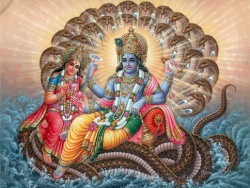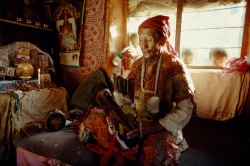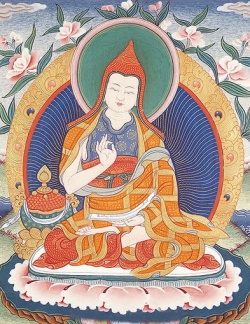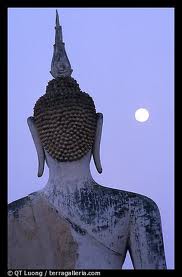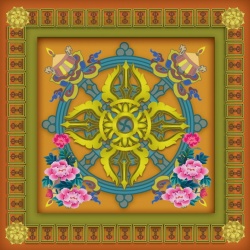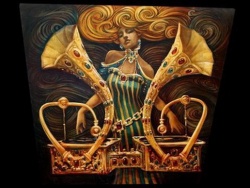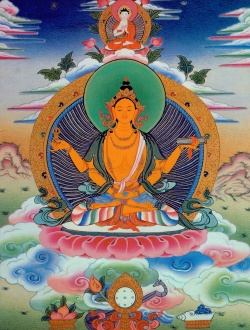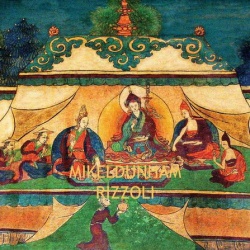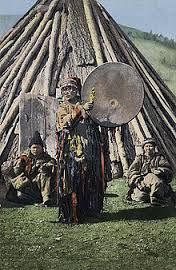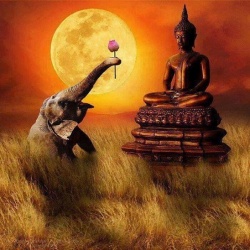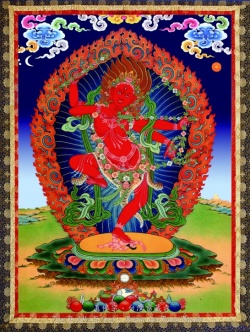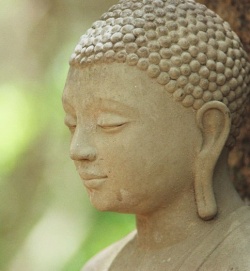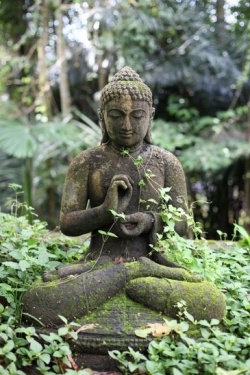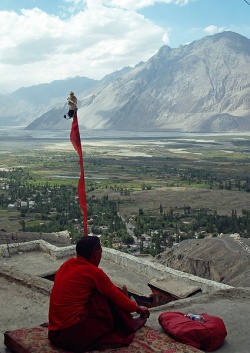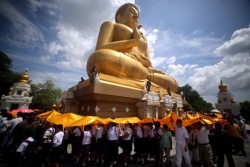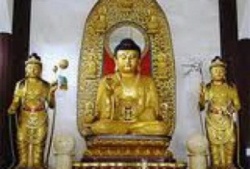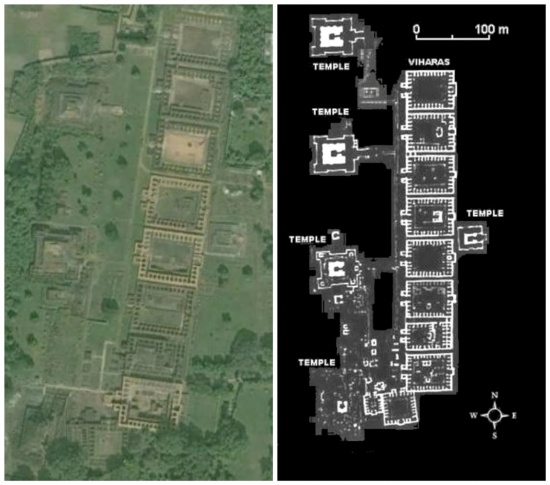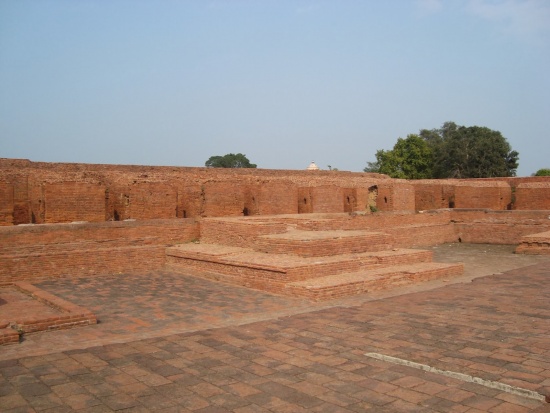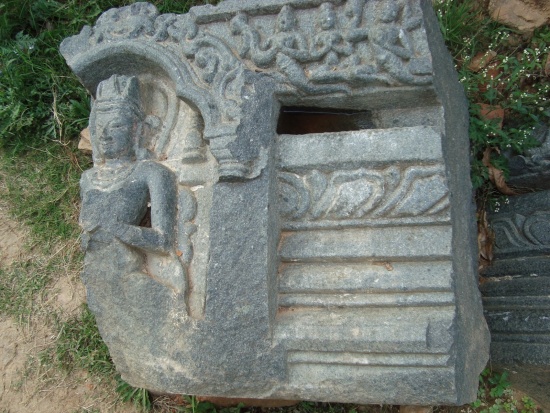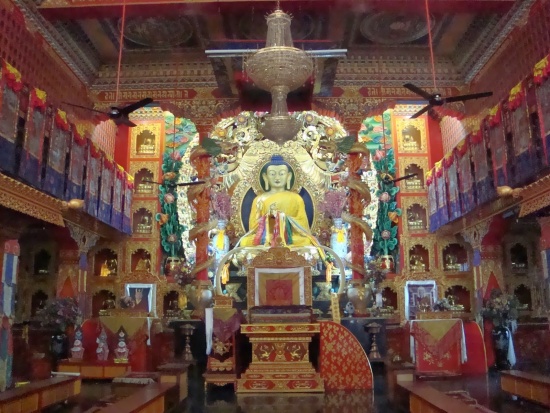From Paupers to Princelings - Contradictions in the Vinaya
From Paupers to Princelings - Contradictions in the Vinaya
by Indrajala (Jeffrey Kotyk)
The Sūtra in Forty-Two Chapters 四十二章經 is an interesting short Buddhist text in Chinese as, like the Pāli Dhammapada, it is a collection of various selected quotes from early Buddhist literature.
According to tradition, it was the first Buddhist text translated into Chinese during the Eastern Han Dynasty (25-220 CE), though modern scholars would place it several centuries later.
Nevertheless, it is translation of quotes from early Indian Buddhist sources, some of which can be identified as being parallel to lines found in the Pāli though not always. The original material would likely have come from a northern Indian language like perhaps Gāndhārī.
The second quote therein perhaps summarizes the ideal of the mendicant monk, which is representative of the early if not original ideals set forth by the historical Buddha:
- 佛言:「除鬚髮,為沙門,受道法,去世資財,乞求取足,日中一食,樹下一宿,慎不再矣!使人愚弊者,愛與欲也。」
- The Buddha said, “He removes his beard and hair, and becomes a śramaṇa. He receives the Dharma of the path, does away with worldly wealth and takes what is sufficient from begging. He eats a single meal at midday, sleeps one night under a tree and is careful not to repeat either of these! It is clinging and desire which make people foolish.”
This model, if actually followed, would disallow the possibility of permanent monasteries. The śramaṇa does not sleep in the same place twice unless it is during the rainy seasons retreat. Nevertheless, for various reasons in history the Buddhist community decided to start building permanent monastic estates. When exactly this happened has yet to be established with any certainty.
- The historical evidence does not allow us to determine with precision when buddhist monks and nuns settled down permanently in monasteries. The first epigraphic evidence for the donation of land to monastic establishments in continental India may date from the first century ce. In Sri Lanka land grants were presumably already given to buddhist monasteries in the latter part of the second century bce, which may not be an unlikely date even for continental India. But whatever its exact date, when this important transition took place, Buddhism became more than ever before dependent upon rich and powerful donors. This in its turn involved it inextricably in political and social issues.
We do however know that in the time of Aśoka (304-232 BCE) there were probably no vihāra-s or formal monasteries. For instance, the pillar erected by Aśoka at Lumbini in 249 BCE reads as follows (Dhammika Bhante's translation):
- Twenty years after his coronation, Beloved-of-the-Gods, King Piyadasi, visited this place and worshipped because here the Buddha, the sage of the Sakyans, was born. He had a stone figure and a pillar set up and because the Lord was born here, the village of Lumbini was exempted from tax and required to pay only one eighth of the produce.
As has been pointed out by Bronkhorst, why is this offering made to the village of Lumbini and not a vihāra? He believes “that this strange state of affairs may mean that Aśoka did not know anything about buddhist monasteries, which indeed may not yet have existed at that time.”
Buddhism as the literary evidence would suggest started off as a community of homeless śramaṇa-s not unlike their counterparts the Jains, though as Schopen has noted there is no actual existent evidence other than proclamations in the literature that such Buddhist mendicancy was ever widespread. One problem modern scholars often have is that they all too often take prescriptions in literature as representative of descriptive historical fact, despite it often being in complete contradiction to the archaeological record.[1]
So, when were the first monasteries built according to the archaeological record? The evidence we have, both epigraphical and archaeological, is critical to our understanding of the development of Vinaya traditions because it reveals how physical developments in the infrastructure of monasteries became reflected in the Vinaya rulebooks which governed their construction and use.
The later inscriptions of Bharhut and Sanchi make no reference to vihāra-s and they only rarely appear in Kharosṭḥī records records around the Common Era, which presumably simultaneous with the first archaeologically verifiable permanent monastic quarters to be built in the northwest of India.[2] The earliest structures were not sophisticated or elegant structures:
- The earliest “monasteries” that are known in India – and none of these are pre-Aśokan – are not “monasteries” at all. They are either only barely improved, unorganized, natural caverns or caves, or poorly constructed and ill-organized shelters built of rubble and other cheap materials. Communities living in these environments could not have produced our elaborate vinayas, nor would they have had any use for them. Since such communities had no steam rooms (jentāka), for example, how could they possibly have generated elaborate rules governing their construction and use?[3]
A few centuries later around the fifth century the grand institution of Nālandā was founded and quickly developed into a large and well-funded institution of higher learning, both for Buddhism and all manner of other subjects. The extant ruins in Bihar, limited as they are in being fully unearthed, reveal an institution of an impressive size that no doubt required a well-organized administration:
By the sixth and seventh centuries when many of the presently visible buildings were built it was an international Buddhist monastery. The famous Chinese pilgrim Xuanzang 玄奘 (602–664) stayed there for a number of years and his account of India goes into great detail about the institution. In many ways it sounded like what we would now called a university. It had multiple faculties dedicated to specific subjects, large dormitories for residents, a sizable staff and many financial endowments.
The modern visitor can easily imagine, walking around the ruins, an austere type of minimalist lifestyle. The red brick buildings, skeletons of what they once were, reveal little internal decorations. However, this is probably not how they actually were. We need to remember what we see now is the framework of the original buildings and not much else. The decorative elements that survived are predictably made of stone, thus anything of cloth or wood have been erased from the archaeological record.
The Mūlasarvāstivāda Vinaya literature, which was in use at Nālandā, often speaks of lavish monasteries complete with beautiful gardens and ornate furnishings provided by benefactors such as stunning paintings and quite agreeable living quarters. For instance, the Vinayavibhaṅga (Derge Cha 156b.4) relates the following:
- … they [some merchants] saw vihāras that had arched gateways, were ornamented with windows, latticed windows, and railings, vihāras that captivated the eye and the heart and were like stairways to heaven, and they were deeply affected (dad par 'gyur te, prasanna). They went to a vihāra and said to the monks: “Noble Ones, we would make an offering feast (mchod ston) for the Community![4]
The opulence of Indian monasteries is confirmed just by a cursory examination of the extant ruins of major institutions such as Mahābodhi Vihāra or Nālandā along with their artifacts in the museums. They were not only decorated with statues which have survived through time until the present day. They evidently also had wall murals and other features similar to what we can see in Inner Asian sites like Dunhuang. The custom of ornamenting halls with statues, wall murals, tapestries and all manner of other fine things is still maintained by Tibetan institutions. For example, the recently constructed Karmapa Temple in Sarnath:
Neverthelss, this is actually at odds with the śramaṇa ideal presented in many Buddhist sūtras. The stoic loners living under trees would obviously have had no use for such facilities, nor the means to really facilitate their construction. Ironically, the austere mendicant monk is, at least in the Mūlasarvāstivāda Vinaya, depicted as undesirable and largely disagreeable – even being mocked. Schopen explains:
- Our Code (Mūlasarvāstivāda Vinaya), for example, does refer to ascetic, meditating monks, but when it does so in any detail, such monks almost always appear the butt of jokes, objects of ridicule, and – not uncommonly – sexual deviants. They are presented as irresponsible and of the type that give the order a bad name. There are texts in our Code where, for example ascetic, cemetery monks manage only to terrify children; where ascetic monks who wear robes made from cemetery cloth are not even allowed into the monastery, let alone allowed to sit on a mat that belongs to the Community; tales whose only point seems to be to indicate that meditation only makes you stupid; texts about monks who meditate in the forest and cannot control their male member and so end up smashing it between two rocks, whereupon the Buddha tells them, while they are howling in pain, that they, unfortunately, have smashed the wrong thing – they should have smashed desire; and a tale about another monk who meditated in the forest and, to avoid being seduced by a goddess, had to tie his legs shut. The goddess being put off by this then flung him through the air and he landed – legs still tied – on top of the king, who was sleeping on the roof of his palace. The king, of course, was not amused and made it known to the Buddha that it would not do to have his monks being flung around the countryside in the middle of the night. The Buddha then actually made a rule forbidding monks to meditate in the forest! Texts and tales of this sort are numerous in our Code.
- The monks with whom our Code is concerned are of a different sort, as even our brief survey indicates. In the passages so far cited, we find monks who have servants and who do not even have to wash their own dishes; monks who eat fine meals in the homes of prominent laymen; monks who are concerned not about meditation but with property, with marking and maintaining control or possession of property, and who have and acknowledge personal property.[5]
Nevertheless, it does seem there were Buddhists who positioned themselves outside such institutions. It seems that some elements at least of the early Mahāyāna had no use for such forms of landed monasticism and pedantic legal procedures. One can see this perhaps in the Vimalakīrti Sūtra, which dates at the latest from the second century CE, not so long after large-scale landed monasticism developed.
It portrays bhikṣus being overly attached to Vinaya rules and essentially mocks such an image (such as Śāriputra complaining to the goddess that being covered in the flowers she showered him in was inappropriate for a monk). However, the Mahāyāna, or at least a significant portion of its followers, inevitably became assimilated into the earlier model they reacted against (for example Mahāyāna and later Vajrayāna were operating in Nālandā despite having initially been fringe movements). Geoffrey Samuel explains as follows:
- In Indian Buddhist history, as in other Indian renunciate traditions, we can see a continual dialectic between forms of Buddhism which have become more or less assimilated to the needs of the state and of 'respectable' society, and others which position themselves at the edges or outside society as a whole. It seems sense to me to see some of the early Mahāyāna material in these terms, although certainly later forms of the Mahāyāna developed into forms of religion fully compatible with the state and urban society. These same process occurs with the developments of 'Tantric' (Vajrayāna) forms of Buddhism, which initially position themselves in large part outside the world of the large monastic centres and of respectable society, but become progressively integrated within it.[6]
It should be recognized that the Vinaya was not so sacrosanct in India. A good work which demonstrates this is the eyewitness account of late seventh century India by the Chinese translator Yijing 義淨 (635-713). Yijing was something of a Vinaya fundamentalist and Indophile, insisting that his fellow clerics in China act more like Indian monks and behave according to the prescriptions given in the Vinaya manuals. Nevertheless, he still describes and advocates behaviors and activities on the part of Indian monks that are actually formally proscribed. In other words, we see stark contradictions between what the manuals demand and how monks actually conducted themselves.
For instance, he provides the following description of monastic inheritance law (probably specifically at Nālandā):
- 《南海寄歸內法傳》卷4:「先問負債囑授及看病人。... 所有券契之物。若能早索得者。即可分之。如不能者。券當貯庫。後時索得充四方僧用。若諸金銀及成未成器貝齒諸錢。並分為三分。一佛陀。二達摩。三僧伽。佛物應修理佛堂及髮爪窣覩波所有破壞。法物寫佛經料理師子座。眾物現前應分。」(CBETA, T54, no. 2125, p. 230, a28-c24)
- First of all one should make an inquiry as to whether he had any debts, or he has left a will, and if anyone nursed him while he was ill. ... Those receipts for loans that are claimable at once may be divided right away. If not claimable at once, they should be kept in the monastic treasury, and when the money is reclaimed at a later time, it should be used to replenish the fund of the community of monks from the four quarters. All gold and silver, either wrought articles or unwrought ingots, should be divided into three portions for the Buddha, the Dharma and the Sangha. The portion for the Buddha should be spent on repairing the Buddha halls and the stupas containing [the Buddha's) hair and nails, and for mending other dilapidation. The portion for the Dharma is used for copying scriptures and maintaining the lion seat. The portion for the community of monks should be shared by them right away.[7]
Yijing also notes that beds inlaid with jewels as well as weapons and armor are to be dealt with as well. That of course begs the question why would a monk possess such contraband items, but nevertheless it seems at least some of the clergy at the time amassed plenty of wealth.
The prātimokṣa (set of precepts) of the Mūlasarvāstivāda Vinaya, like the Dharmagupta Vinaya commonly used in East Asia, does in fact prohibit a monk from “holding” gold, silver and money. If they do it then constitutes a naiḥsargika-prāyaścittika offense,[8] which is more or less equivalent in terms of severity as consuming alcohol. Nevertheless, the same tradition also establishes rules regarding the possession and transmission of lawful private property and money, which only stand to confirm Yijing's observations of late seventh century Buddhism in north India.
Schopen in his study of the Mūlasarvāstivāda Vinaya lists a number of monastic activities that stand contrary to the prātimokṣa of the Vinaya:
- Accept and possess money (kārṣāpaṇa).
- Pay debts and tolls.
- Transport goods.
- Possess personal funds for damages caused to the property of others.
- Own personal property like furniture.
- Possess personal seals.
- Pay for one's own healthcare and healing rituals.
- Leave large estates.
- Borrow money from laymen.
- Inherit property from both fellow sangha and laypeople.
- Manage permanent endowments.
- Provide loans at interest.
- Accept and use negotiable securities.
- Provide care for the ill and dying laity, and accept their estates upon death.
- Accept and possess both precious and semiprecious materials.
- Sell the property of deceased monks.
- Hire and manage laborers.
- Purchase food.
Schopen goes on to say these were “not only expected but also required to do by their own monastic rule. If they did not, then – at least in terms of monastic discipline – they would not be 'good' monks.”[9] Some Buddhist monks were clearly akin to bankers, at least part of time.
It seems preferential treatment was also increasingly provided to the rich and powerful. In Xuanzang's Chinese translation of the Saṃgītiparyāya between 660-664 it clearly states that anyone “who knows Dharma, has attained great wealth, status, a great clan, great power, a great retinue or a great following” is to be provided upper seating in the assembly, being made offerings and venerated. It also explicitly states that anyone with great wealth among the merchants is to be provided upper seating.[10] Clearly there was a perceived need to please and reward rich benefactors, which is still common in Buddhist traditions today.
This text is significant being the first work of the Sarvāstivāda Abhidharma canon. According to the Chinese tradition it was recited by Śariputra, though according to the Abhidharmakośavyākhyā by Yaśomitra as well as the Tibetan tradition it was recited by Mahākauṣṭhila. In addition, the text is quoted in later Abhidharma literature. Fragments of the Sanskrit text were also found at Bāmiyān in Afghanistan.[11] Thus we have a canonical and well-studied text of presumably early composition and status providing special perks to the rich and powerful.
This is perhaps unsurprising considering the union between merchants and the Buddhist sangha that emerged early on. The growth in trade in the centuries following the mature development of the second urbanization of India saw merchant communities investing heavily in religious institutions.
The modern scholar Romila Thapar has written that the “prosperity of the merchant community is evident from their donations to religious institutions, and from descriptions of wealthy merchants in the literature of the time. Not surprisingly, the religions supported by the merchants, pre-eminently Buddhism and Jainism, saw their heyday during these centuries [200 BCE-300 CE].”[12] Monasteries were often built in or near towns catering to merchants, caravans and pilgrims.[13] The reason a code like the Mūlasarvāstivāda Vinaya was extensively expanded with respect to financial matters was because Buddhist communities around India were part of the international trade network, most notably with the Hellenic and Roman worlds.[14] Giovanni Verardi explains:
- Buddhism has long been judged as belonging to an urban and mercantile environment, of which it represents the religious and ideological referent. Early Buddhist establishments were located just outside cities and, in the vast non-urbanised regions of the sub-continent, along the communication routes that joined distant and different areas. Overseas trade was already well developed from the second half of the second century BE, in times of Republican Rome, but intensified enormously from the age of Augustus and Tiberius onwards. The new large ships that made the direct route between Aden and the Deccan possible attest to the extraordinary boom of maritime traffic in the Arabian Sea. The Buddhist monasteries were often able to supply merchants and caravans with the capital they needed; loans and sales to cultivators and merchants are documented, especially by the Mahāsāṃghika communities, which we have mentioned for their docetist orientation. To give some examples, at Nāsik the local saṃgha received a money grant from the wives and daughters of some merchants thanks to the investments of the corporations of potters, plumbers, and the owners of oil presses. At Junnar, the saṃgha invested with corporations of the bamboo workers and of the coppersmiths. The monasteries were not only stopping places but also centres with functions of supplying and banking. The models are, clearly, the banking functions of the Greek and Hellenistic temples, which in Roman times prospered especially in the eastern Mediterranean area.[15]
Buddhism was not only adapting to new economic models which supported their increasingly complex monastic operations. The Vinaya also had to be adjusted and revised to suit the values and expectations of an increasingly Brahmanical society.
Bronkhorst in his work Buddhism in the Shadow of Brahmanism argues that Buddhism had initially emerged in a “Greater Magadha” within which initially was negligible Brahmanical influence and power, which was in contrast to the western “Kuru-Pañcāla region” where Vedic orthodoxy and a strict caste system were developed. It was traditions of śramaṇa-s and non-Sanskrit speakers who were culturally dominate in the Buddha's age, though later on Brahmanical authority grew and in time north Indian society came to be dominated by Brahmanical values, so much that Sanskrit was adopted as the lingua franca, even by Buddhists:
- They did not do so because they liked Sanskrit, or because they liked the Brahmins whose language it was. Nor did they do so for some inherent quality that this language supposedly possesses. They did so because they needed to defend their interests at the royal courts in Sanskrit. They had to use Sanskrit at the courts because Brahmins had been able to secure themselves a central place at the courts by way of their indispensable skills, not because rulers had supposedly “converted” to Brahmanism. This, as far as I can see, is the most plausible explanation of this otherwise puzzling change of language.[16]
It should be noted here that the idea of the Buddha effectively being a reactionary to Brahmanism is highly problematic. Geoffrey Samuel summarizes why as follows:
- As for the suggestion, still prevalent in the popular literature, that Buddhism represented a protest against the pre-existing Brahmanical caste system, there seems little truth in this. The Buddha's comments on Brahmin claims of high caste suggest less an opposition to an already imposed caste system than a refusal by a spiritual leader belonging to an established group of high status to accept a new imported Vedic-Brahmanical model in which the Brahmins are supreme. References to Vedic material in the earliest Buddhist literature are limited although there is evident knowledge of the existence of the Rg, Sāma and Yajur Vedas and suggestions of detailed engagement with Vedic ideas.[17]
That being said, early Buddhism within a few centuries, perhaps from around Aśoka's time onward, started becoming heavily influenced by Brahmanical values, which is actually again reflected in some Vinaya literature such as the Mūlasarvāstivāda Vinaya.
For instance, monks who perform at or participate in the funeral of the deceased monk have priority access and right to inherit the property of the deceased. Probably by no coincidence do these conform to Dharmaśāstric conventions (i.e., Brahmanical laws) regarding inheritance. The Baudhāyana Pitṛmedha Sūtra states that appropriate cremation rites are to be performed for anyone who leaves inheritance to the living individual in question, and this includes not only relatives and those with whom one has religious ties, regardless of their gotra.
A lack of conformity to prevailing norms with respect to funerals and disposal of corpses would have brought down censure and condemnation on the sangha. Predictably, the Vinaya authors with their perpetual if not obsessive concern for the public image of the sangha, adapted their laws to suit Brahmanical norms and even “put words into the Buddha's mouth”.[18]
It is commonly thought that only Mahāyāna authors would attribute their new teachings to Śākyamuni, though in reality Śrāvakayāna bards did the same thing, especially with Vinaya texts of different schools which all display signs of later developments and a Buddha purportedly making rules for a type of landed monasticism that did not exist in his day. One evident example of this is in the Vinayavibhaṅga (Derge, 'dul ba Cha 154b.3-155b.2) of the Mūlasarvāstivāda school where the ancient author(s) was unaware that there was no writing in Magadha in the Buddha's time:
- The Blessed One said: “Taking a pledge (ādhi/bhandhaka) of twice the value (dviguṇa), and writing out a contract (likhita) that has a seal and is witnessed (sākṣimat), the perpetuity is to be placed. In the contract the year, the month, the day, the name of the Elder of the Community (saṃghasthavira), the Provost of the monastery (upadhivārika), the borrower, the property, and the interest (vṛddhi) should be recorded. When the perpetuity is placed, that pledge of twice the value is also to be placed with a devout lay-brother who has undertaken the five rules of training.[19]
The earliest known use of written script after the fall of Harappa is Aśoka's inscriptions in the mid third century BCE, long after the Buddha died. Moreover, the Seleucid ambassador Megasthenes (350-290 BCE), author of the now lost work Indika, reported that Indians had no knowledge of writing. Here we have the Buddha anachronistically placed in another time period addressing financial concerns which the historical Śākyamuni presumably would not have had much use for.
The Buddhist bardic tradition throughout Indian history have constantly revised or drafted their texts in such a fashion. Just how much this happened with the Pāli canon – which is generally considered the most accurate record of the historical Buddha available to us – is another question worth considering. The historicity of any Indian Buddhist literature will always be called into question, and calls for a separate discussion. Here in the meanwhile we might take Bronkhorst's remarks into consideration:
- It is not easy to get a clear picture of the Buddha's original teaching. Certainly, its aim was to stop suffering and rebirth. To achieve this, the Buddha taught a path in which consciousness played a major role. This is clear from the awareness practices and from the four stages of meditation. In the highest stage of meditation, it is somehow possible, with the help of wisdom (prajñā), to bring about a decisive transformation. Once this happens, the goal is attained.[20]
So, what can we take away from this discussion? Basically, the original śramaṇa tradition the Buddha was a part of gave way for various reasons to landed monasticism, which initiated a process of increasingly complex legal developments to govern such institutions, notably with respect to financial matters and maintaining agreeable relations with lay benefactors.
The evident preoccupation of Vinaya lawyers – who, should be noted, had no problems attributing their own proclamations to Śākyamuni Buddha himself – was with self-preservation of their institutions and clergy. As Buddhism in India became rather wealthy it was able to expand its infrastructure and operations in ways until then would have proven infeasible.
In opposition to the Brahmins, the Buddhists and merchant classes cooperated with one another – the monks were fields of merit and trustworthy bankers while the merchants reciprocated with heavy investment in the religion which they benefited from both socially and financially. The Vinaya lawyers to maintain the functionality of their orders clearly revised Vinaya literature to suit evolving social values and economic concerns. As a result it seems, at least among landed monastics, the ideal of a śramaṇa sleeping under a different tree every night became unpopular and largely unknown.
What this all means from the Buddhist emic perspective at present is a whole other matter. If the contemporary Buddhist sangha accept that their Vinaya codes are largely not attributable to the historical Buddha or even the early sangha, then the sacrosanct quality of precepts and full Vinaya ordination might falter. Moreover, a lot of the revisions to Vinaya literature, especially the Mūlasarvāstivāda Vinaya which is in use by Tibetan traditions, were clearly motivated by worldly concerns, many of which were placed into the mouth of the Buddha. This is perhaps a very unwelcome idea to propose in some circles, though nevertheless the findings of modern scientific scholarship have a tendency to “trickle down” over time. At least amongst westerners these concerns will have to be addressed eventually, unless the community at large continues largely ignoring, apart from the lists of precepts, the actual full content of the Vinaya.
Footnotes
- ↑ Schopen:
- [S]cholars of Indian Buddhism have taken canonical monastic rules and formal literary descriptions of the monastic ideal preserved in very late manuscripts and treated them as if they were accurate reflections of the religious life and career of actual practicing Buddhist monks in early India. Such a procedure has, of course, placed archaeology and epigraphy in a very awkward position. If, then, archaeology and epigraphy are to be in the service of a “history” based on written sources of this kind, then they are going to have to “support and amplify” something that very probably did not exist: they are going to have to sit quietly in a corner spinning cloth for the emperor's new clothes.
See Gregory Schopen, “Archaelogy and Protestant Presuppositions” in Indian Monastic Buddhism Collected Papers on Textual, Inscriptional and Archaelogical Evidence (New Delhi, India: Motilal Banarsidass Publishers Private Limited, 2010), 3.
- [S]cholars of Indian Buddhism have taken canonical monastic rules and formal literary descriptions of the monastic ideal preserved in very late manuscripts and treated them as if they were accurate reflections of the religious life and career of actual practicing Buddhist monks in early India. Such a procedure has, of course, placed archaeology and epigraphy in a very awkward position. If, then, archaeology and epigraphy are to be in the service of a “history” based on written sources of this kind, then they are going to have to “support and amplify” something that very probably did not exist: they are going to have to sit quietly in a corner spinning cloth for the emperor's new clothes.
- ↑ Johannes Bronkhorst, Buddhism in the Shadow of Brahmanism Handbook of Oriental Studies (Leiden: Brill, 2011), 18-19. Schopen is quoted here.
- ↑ Gregory Schopen, “The Good Monk and His Money in Monasticism of 'the Mahāyāna Period'” in Indian Monastic Buddhism Collected Papers on Textual, Inscriptional and Archaelogical Evidence (New Delhi, India: Motilal Banarsidass Publishers Private Limited), 1-2.
- ↑ Translation by Schopen. Gregory Schopen, “Art, Beauty, and the Business of Running a Buddhist Monastery in Northwest India” in Indian Monastic Buddhism Collected Papers on Textual, Inscriptional and Archaelogical Evidence (New Delhi, India: Motilal Banarsidass Publishers Private Limited), 32.
- ↑ Gregory Schopen, “Art, Beauty, and the Business of Running a Buddhist Monastery in Northwest India” in Indian Monastic Buddhism Collected Papers on Textual, Inscriptional and Archaelogical Evidence (New Delhi, India: Motilal Banarsidass Publishers Private Limited), 26.
- ↑ Geoffrey Samuel, The Origins of Yoga and Tantra Indic Religions to the Thirteenth Century (New Delhi, India: Cambridge University Press, 2008), 214-215.
- ↑ English translation by Li Rongxi. See Buddhist Monastic Traditions of Southern Asia (Berkeley, CA: Numata Center for Buddhist Translation and Research, 2000), 157-161.
- ↑ 《根本說一切有部戒經》卷1:「若復苾芻自手捉金銀錢等。若教他捉。泥薩祇波逸底迦。」(CBETA, T24, no. 1454, p. 503, b5-7)
- ↑ “The Good Monk and His Money in Monasticism of 'the Mahāyāna Period'”, 14-15.
- ↑ 《阿毘達磨集異門足論》卷4〈4 三法品〉:「云何世俗上座。答如有知法富貴長者共立制言。諸有知法大財大位。大族大力大眷屬大徒眾。勝我等者我等皆應推為上座。供養恭敬尊重讚歎。... 如商侶中有多財者眾人和合推為上座。供養恭敬尊重讚歎。」(CBETA, T26, no. 1536, p. 380, c1-11)
- ↑ See Digital Dictionary of Buddhism, http://www.buddhism-dict.net/ddb/ (edited by Charles Muller): 阿毘達磨集異門足論 by U. Kragh.
- ↑ Romila Thapar, The Penguin History of Early India From the Origins to AD 1300 (London, England: Penguin Books Ltd, 2002), 245.
- ↑ Ibid., 270.
- ↑ Romila Thapar explains the significance of the trade:
- Roman historian Pliny complained of the trade with the east being a serious drain on the income of Rome, to the extent of 550 million sesterces each year, of which at least a fifth went to India. Imports from India were largely luxury articles - spices, jewels, textiles, ivories and animals (apes, parrots and peacocks) for the amusement of the Roman patrician and his family. It was therefore thought that the balance of trade was in favour of India. But recently it has been argued that even if Pliny's figure is correct, customs dues and taxes on the imports from the east into Roman Egypt were high enough to compensate for the drain of money in the initial outlay for this trade. It has also been argued that Tiberius and later Pliny, both of whom complained about the drain of Roman wealth to India, may have been more concerned about making a moral judgment on Roman patrician society with its display of wealth, and therefore used the trade to underline the point. Nevertheless, it was a profitable trade for the merchants and chiefs of the Indian peninsula.
- Roman historian Pliny complained of the trade with the east being a serious drain on the income of Rome, to the extent of 550 million sesterces each year, of which at least a fifth went to India. Imports from India were largely luxury articles - spices, jewels, textiles, ivories and animals (apes, parrots and peacocks) for the amusement of the Roman patrician and his family. It was therefore thought that the balance of trade was in favour of India. But recently it has been argued that even if Pliny's figure is correct, customs dues and taxes on the imports from the east into Roman Egypt were high enough to compensate for the drain of money in the initial outlay for this trade. It has also been argued that Tiberius and later Pliny, both of whom complained about the drain of Roman wealth to India, may have been more concerned about making a moral judgment on Roman patrician society with its display of wealth, and therefore used the trade to underline the point. Nevertheless, it was a profitable trade for the merchants and chiefs of the Indian peninsula.
- ↑ Giovanni Verardi, Hardships and Downfall of Buddhism in India (New Delhi, India: Manohar, 2011), 73.
- ↑ Johannes Bronkhorst, Buddhism in the Shadow of Brahmanism Handbook of Oriental Studies (Leiden: Brill, 2011), 129.
- ↑ Geoffrey Samuel, 100.
- ↑ Gregory Schopen, “On Avoiding Ghosts and Social Censure Monastic Funerals in the Mūlasarvāstivāda-vinaya” in Indian Monastic Buddhism Collected Papers on Textual, Inscriptional and Archaelogical Evidence (New Delhi, India: Motilal Banarsidass Publishers Private Limited), 214.
- ↑ Translation by Schopen. “Doing Business for the Lord Lending on Interest and Written Loan Contracts in the Mūlasarvāstivāda-vinaya”, 48.
- ↑ Johannes Bronkhorst, Buddhist Teaching in India (Somerville, MA: Wisdom Publications, 2009), 58
